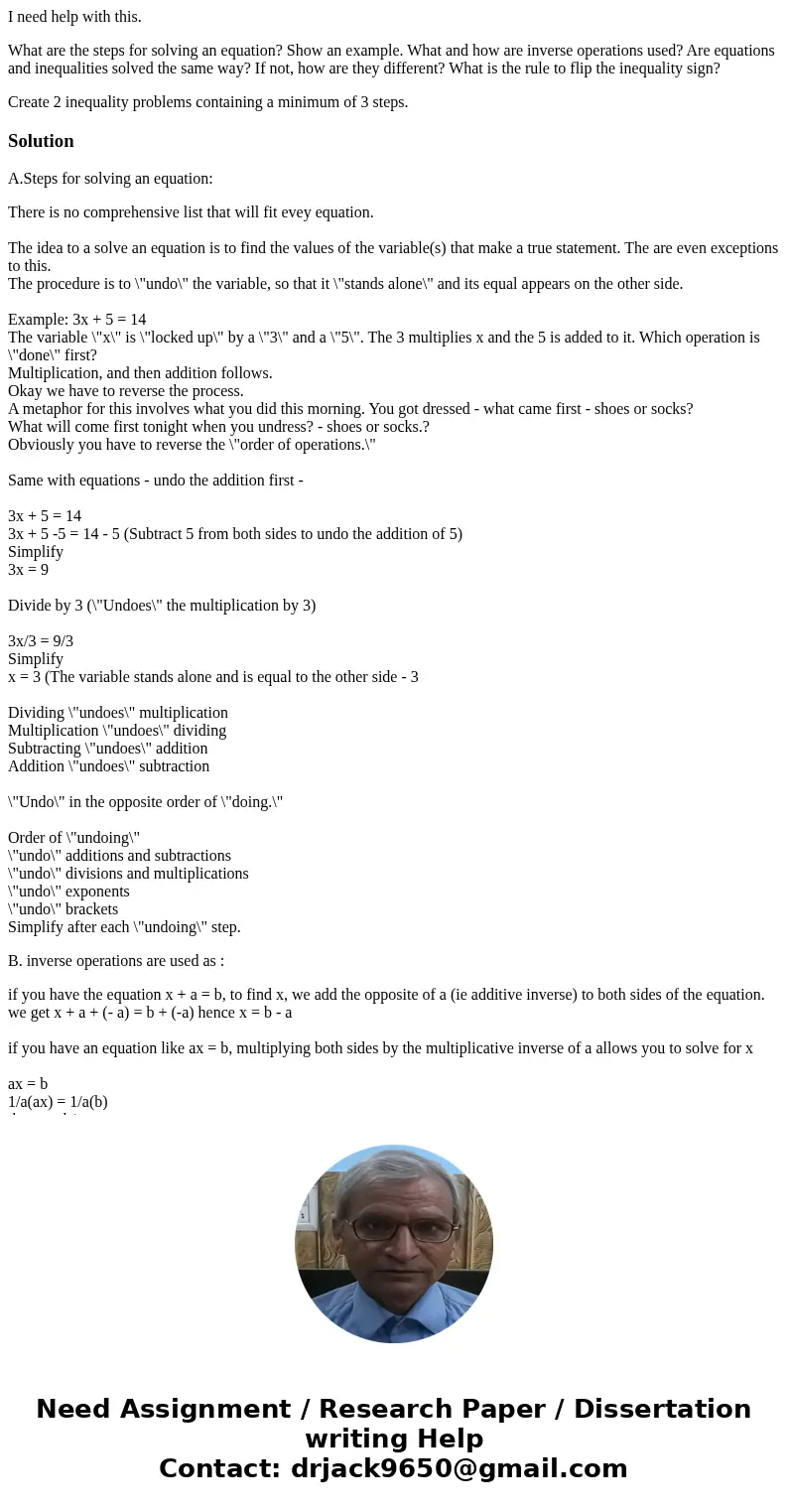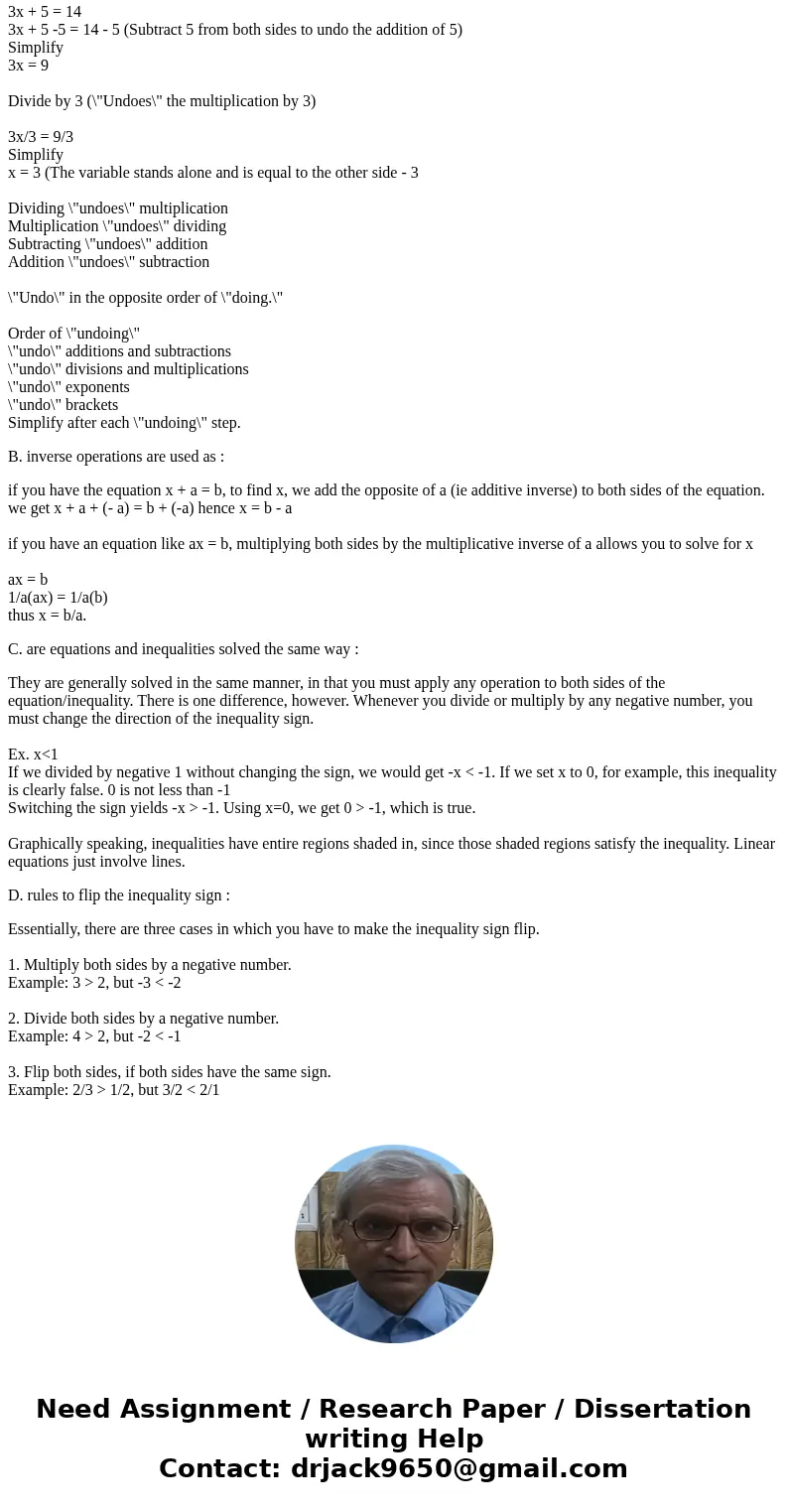I need help with this What are the steps for solving an equa
I need help with this.
What are the steps for solving an equation? Show an example. What and how are inverse operations used? Are equations and inequalities solved the same way? If not, how are they different? What is the rule to flip the inequality sign?
Create 2 inequality problems containing a minimum of 3 steps.
Solution
A.Steps for solving an equation:
There is no comprehensive list that will fit evey equation.
The idea to a solve an equation is to find the values of the variable(s) that make a true statement. The are even exceptions to this.
The procedure is to \"undo\" the variable, so that it \"stands alone\" and its equal appears on the other side.
Example: 3x + 5 = 14
The variable \"x\" is \"locked up\" by a \"3\" and a \"5\". The 3 multiplies x and the 5 is added to it. Which operation is \"done\" first?
Multiplication, and then addition follows.
Okay we have to reverse the process.
A metaphor for this involves what you did this morning. You got dressed - what came first - shoes or socks?
What will come first tonight when you undress? - shoes or socks.?
Obviously you have to reverse the \"order of operations.\"
Same with equations - undo the addition first -
3x + 5 = 14
3x + 5 -5 = 14 - 5 (Subtract 5 from both sides to undo the addition of 5)
Simplify
3x = 9
Divide by 3 (\"Undoes\" the multiplication by 3)
3x/3 = 9/3
Simplify
x = 3 (The variable stands alone and is equal to the other side - 3
Dividing \"undoes\" multiplication
Multiplication \"undoes\" dividing
Subtracting \"undoes\" addition
Addition \"undoes\" subtraction
\"Undo\" in the opposite order of \"doing.\"
Order of \"undoing\"
\"undo\" additions and subtractions
\"undo\" divisions and multiplications
\"undo\" exponents
\"undo\" brackets
Simplify after each \"undoing\" step.
B. inverse operations are used as :
if you have the equation x + a = b, to find x, we add the opposite of a (ie additive inverse) to both sides of the equation.
we get x + a + (- a) = b + (-a) hence x = b - a
if you have an equation like ax = b, multiplying both sides by the multiplicative inverse of a allows you to solve for x
ax = b
1/a(ax) = 1/a(b)
thus x = b/a.
C. are equations and inequalities solved the same way :
They are generally solved in the same manner, in that you must apply any operation to both sides of the equation/inequality. There is one difference, however. Whenever you divide or multiply by any negative number, you must change the direction of the inequality sign.
Ex. x<1
If we divided by negative 1 without changing the sign, we would get -x < -1. If we set x to 0, for example, this inequality is clearly false. 0 is not less than -1
Switching the sign yields -x > -1. Using x=0, we get 0 > -1, which is true.
Graphically speaking, inequalities have entire regions shaded in, since those shaded regions satisfy the inequality. Linear equations just involve lines.
D. rules to flip the inequality sign :
Essentially, there are three cases in which you have to make the inequality sign flip.
1. Multiply both sides by a negative number.
Example: 3 > 2, but -3 < -2
2. Divide both sides by a negative number.
Example: 4 > 2, but -2 < -1
3. Flip both sides, if both sides have the same sign.
Example: 2/3 > 1/2, but 3/2 < 2/1


 Homework Sourse
Homework Sourse